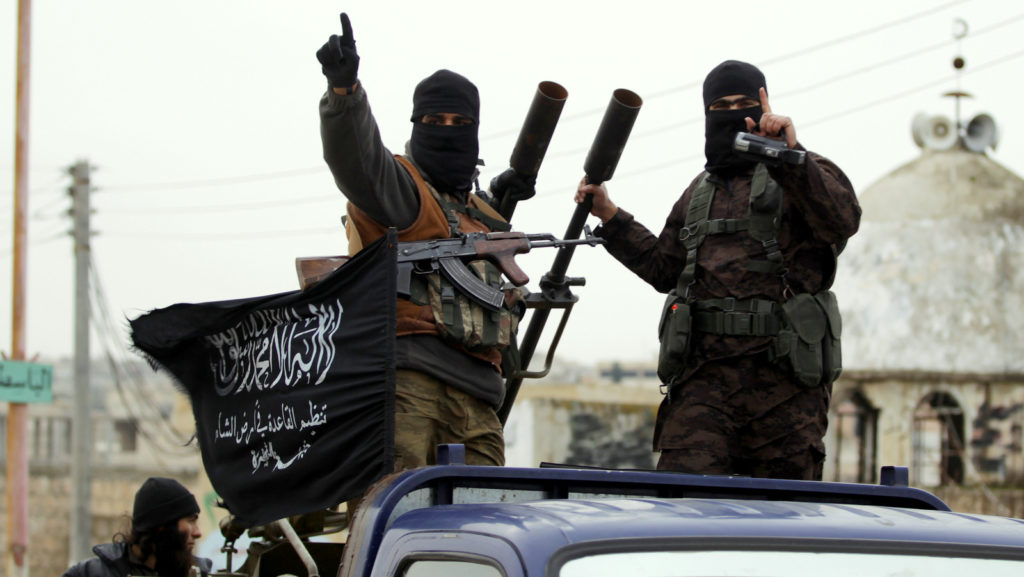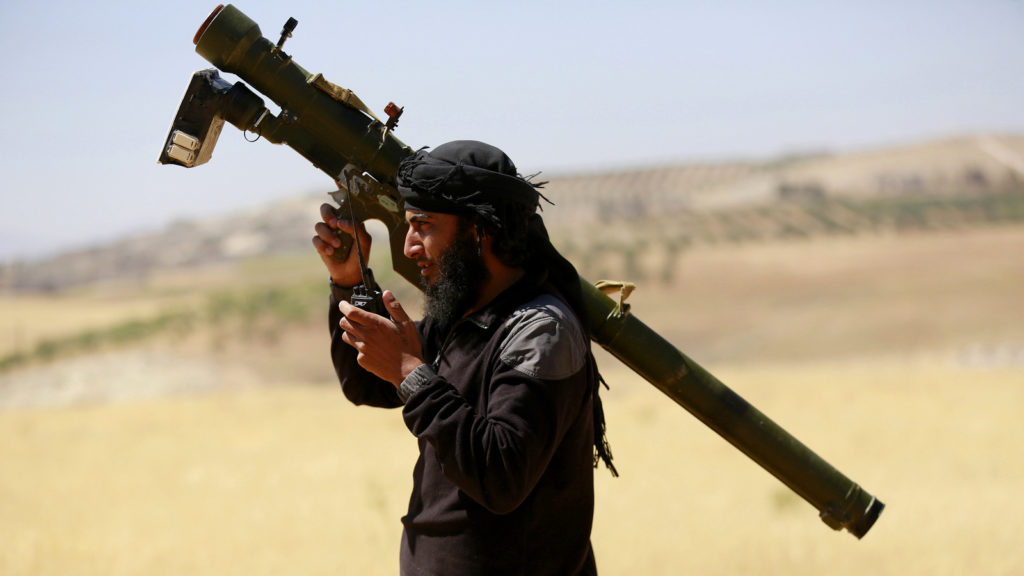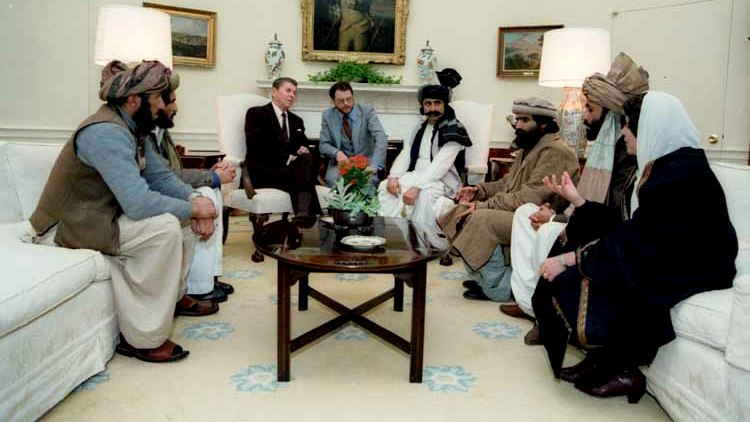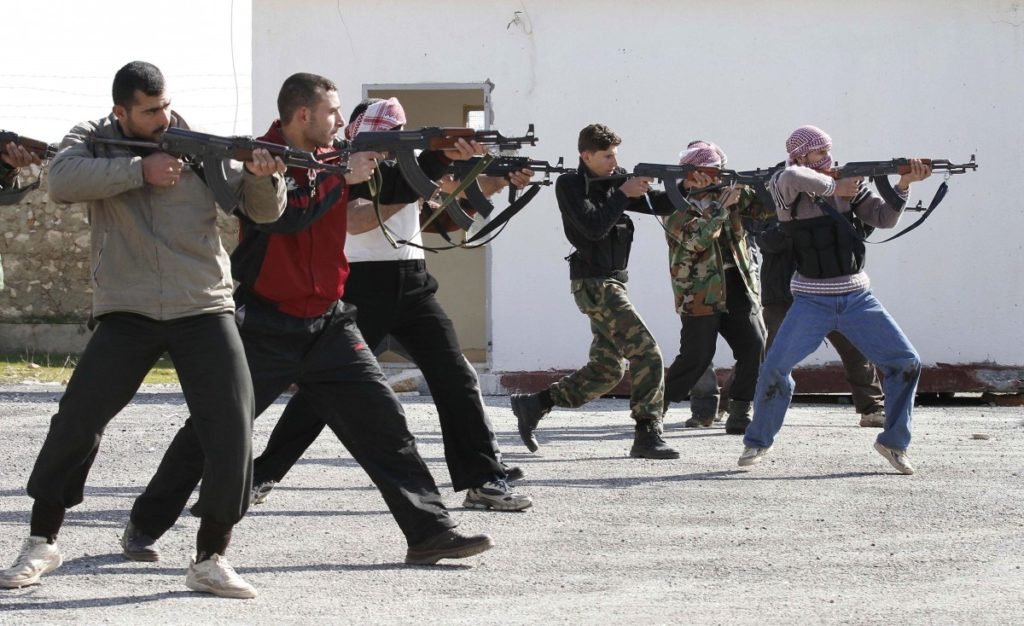How al-Qaeda Became an American Ally in ‘The War on Terror’
MILITARISM, 10 Jul 2017
Nearly 16 years since the 9/11 terrorist attacks, the United States is inexplicably finding itself in bed with al-Qaeda, its alleged sworn enemy. The group’s efforts to terrorize the population of Syria have been rewarded with U.S. arms, training and other military aid.

Members of al-Nusra Front gesture as they drive in a convoy touring villages in the southern countryside of Syria’s Idlib province, Decembe, 2014.
(Photo: Khalil Ashawi/Reuters)
3 Jul 2017 – Despite ostensibly being the United States’ “Public Enemy No. 1” following the 9/11 attacks, the international terror group al-Qaeda has instead been a beneficiary of U.S. military aid in the post-9/11 world, particularly in Syria. With the Syrian conflict well into its sixth year, al-Qaeda’s active branch in that war, widely known as Jabhat al-Nusra or the al-Nusra Front, has continually received arms and military protection from the United States, an outcome that is clearly counterproductive to the U.S.’ global “War on Terror.”
Yet, while the arming and propping up of al-Qaeda in Syria may not serve the U.S.’ fundamental goal of eradicating terrorism, it certainly has helped the U.S. political establishment pursue a decades-old goal of regime change in regionally strategic Syria.
Gareth Porter, an award-winning independent investigative journalist, and historian told MintPress News that such tactics are part of the U.S. government’s long-standing “bureaucratic habit of mind that really privileges short-term advantages against state adversaries over the long term, fundamental interests of the American people.”
In this case, U.S. counter-terrorism efforts have been usurped by the government’s broader geopolitical interests in reshaping the Middle East. While Washington politicians and bureaucrats may be content with having helped extend Syria’s “civil war” to their benefit and the benefit of their allies, this reality has had the ugly consequence of the U.S. willfully sponsoring terrorists who torture civilians to death, regularly conduct mass executions, kidnap children and mutilate the bodies of their victims.
U.S. funneled Libyan arms, chemical weapons to “rebels”
The U.S.’ arming of al-Nusra began when the conflict in Syria was in its infancy. In September 2011, the Obama administration began providing logistical assistance to anti-Assad forces – namely the Free Syrian Army, Syrian Revolutionaries Front, the Democratic Forces of Syria and related groups – who were then supported by U.S. allies Qatar, Saudi Arabia and Turkey. These groups received an estimated $1 billion from the CIA every year from 2012 until the program was scaled back in 2015. In addition, the U.S. government gave another $500 million to the “rebels” in 2014 which was intended to train thousands of opposition fighters – an operation that turned out to be remarkably ineffective.
A year later, the CIA initiated weapon shipments to these foreign-funded “rebels” by funneling weapons that once belonged to the fallen Gaddafi regime in Libya to anti-government militias in Syria.
As Gareth Porter details in his recent piece “How America Armed Terrorists in Syria,” the CIA continued to connect U.S. regional allies directly arming the opposition with weapons from Libya and former Soviet bloc countries, resulting in an estimated 8,000 tons of weapons being poured into Syria in less than four months, from December 2012 to mid-March 2013. The quantity of weapons that flooded into Syria from 2011 until that time undoubtedly dwarfs this figure.
In addition, the U.S. secured more than just conventional arms being shipped to Syria. For instance, Pulitzer Prize-winning journalist Seymour Hersh exposed how the Gaddafi regime’s chemical weapon stores were also sent to foreign-backed opposition forces in Syria, including sarin gas. Hersh has suggested that former Secretary of State Hillary Clinton approved the chemical weapon transfers.
Related: Israel Accepts Billions from the US, but Maintains Ties with Al-Nusra
While the U.S. was not directly arming al-Nusra specifically at this time, the terror group’s effectiveness at combating the Syrian government, along with their ruthlessness, quickly made them the darlings of Saudi Arabia and Qatar, who were funding the “rebels” with their own money and with U.S. assistance.
By late 2012, the U.S. was well-aware that most of the arms it was sending into the country were going to Syria’s al-Qaeda offshoot. As the New York Times reported in October 2012, U.S. officials acknowledged off the record that “most” of the arms shipped to Syrian “rebels” with U.S. support had ended up in the hands of “hardline Islamic jihadists.”
However, internal government communications reveal that the government knew that such “jihadists” were al-Nusra. A now-declassified U.S. government internal report from 2012 stated that the “the Salafists, the Muslim Brotherhood and AQI [al-Qaeda in Iraq] are the major forces driving the insurgency in Syria.” However, no efforts were taken to halt the U.S.-supported flow of arms to such groups, which continued years after this surprisingly frank admission.
Other evidence from that same year has suggested that this “oversight” was intentional. For instance, a 2012 email written by Jacob Sullivan and sent to then-Secretary of State Hillary Clinton stated that “AQ [al-Qaeda] is on our side in Syria,” implying a tacit alliance of sorts between the U.S. government and known terrorist elements that dominated the Syrian armed opposition.
Despite the true nature of the foreign-funded opposition being well-known to U.S. officials, the arming of these so-called “rebel” groups only became more rampant in the years that followed, with the U.S. supplying them with heavy weaponry, such as anti-tank missiles and anti-aircraft weapons, while also providing them with training.
The advantage of such substantial support from the U.S. and its regional allies has only led to the rapid growth and strengthening of al-Nusra, enabling them to out-compete and eventually absorb nearly all groups belonging to the U.S.-backed “moderate rebels” active within Syria.
As al-Nusra’s influence grew, many “moderate” groups who shared similar ideas began to work alongside the terror group and eventually became part of it or directly allied with it. Among the first to do so were U.S.-supported groups such as Ahrar al-Sham and Jaysh al-Islam, whose cooperation and close relationship with al-Nusra has been documented by the pro-opposition Syrian Observatory for Human Rights (SOHR).
But the U.S. had no complaints when Jaysh al-Islam led the Syrian opposition at peace talks in Geneva in 2016. In addition, the U.S. has consistently refused to add al-Nusra collaborators to the UN terrorist list, prompting some journalists to call such a refusal an “unwitting U.S. admission” regarding who really leads the “rebellion” in Syria.
According to the Russian Defense Ministry, the vast majority of Syrian opposition groups supported by the U.S. form “an integral part” of al-Nusra front. Even the mainstream press in the United States has admitted that most “rebel” groups have been overtaken by al-Nusra. For instance, in February, the Washington Post quoted an official with the U.S.-backed Fastaqim rebel group as saying “Al-Qaeda is eating us” and that al-Qaeda’s influence and power led his group chose to join the al-Nusra affiliated group Ahrar al-Sham.
As University of Oklahoma Center for Middle East Studies Director Joshua Landis told Sputnik last year: “The United States has placed itself in a very difficult situation because many of the rebel groups that it wants to become principal holders of state power in Syria work hand and glove with Al-Qaeda.”
Supporting al-Qaeda from the shadows
While the arming of Syrian “rebels” that are either members of or affiliated with al-Nusra should be controversial enough, the U.S. government has also managed to aid the terror group in other ways, offering them protection and covert tools to bolster their ranks.
The U.S. State Department and the U.S. military have long justified the presence of U.S. military personnel and assets within Syria as being directly aimed at fighting terrorists within that nation, namely Daesh (ISIS). However, on repeated occasions, the U.S. has worked to protect al-Nusra by asking the Russian military and Syrian government to avoid targeting the terror group.
Such requests have led Russia to call the U.S.’ commitment to fighting al-Nusra into question, with Russian Foreign Minister Sergey Lavrov stating in October last year that the Russian government “doesn’t see any facts that the U.S. is seriously battling al-Nusra.”

A Jabhat al-Nusra fighter talks on a radio while carrying his weapon in the front line of Khan Sheikhoun, northern Idlib province, May, 2014. (Photo: Hamid Khatib/Reuters)
However, the words of al-Nusra members themselves paint an even more disturbing picture of direct U.S. involvement in aiding the group. In an interview with German newspaper Koelner Stadt-Anzeiger, an al-Nusra unit commander named Abu Al Ezz stated that when al-Nusra was under siege from the Syrian and Russian governments that “we had officers from Turkey, Qatar, Saudi Arabia, Israel and America here…Experts in the use of satellites, rockets, reconnaissance, and thermal security cameras.”
When asked to confirm the presence of U.S. instructors within its ranks, Al Ezz replied “the Americans are on our side,” echoing a 2012 email exchange between Hillary Clinton and her advisor Jacob Sullivan regarding al-Qaeda in Syria.
Perhaps this explains why the “Stop Arming Terrorists Act” introduced by Hawaiian Democratic Senator Tulsi Gabbard, which would bar federal agencies from using taxpayer-backed funds to provide weapons, training or any other type of support to terrorist cells such as al-Qaeda, Daesh or any other group associated with them, was only supported by 2 percent of U.S. congressmen.
U.S.’ history of flirting with terrorist groups for geopolitical gain
While the strategy of arming al-Qaeda affiliated terrorists and extremists in Syria may seem bizarre, it is actually part of a long-standing U.S. government practice that led to the terror group’s founding in the first place. Indeed, al-Qaeda is the textbook example of the U.S. creating and arming a terror group for political purposes.
Under the presidency of Ronald Reagan, the U.S. government sent billions of dollars in military aid to the mujahideen in Afghanistan as part of a U.S.-supported “jihad” against the Soviet Union. These extremist fighters, led by Osama bin Laden, would soon become known as al-Qaeda. Gareth Porter told MintPress that the creation of al-Qaeda under the Reagan administration “set the precedent for the U.S. to support jihadi forces where and when it is deemed to serve broader U.S. political and diplomatic aims.”

Ronald Reagan meeting in the White House with leaders of the Afghan mujahideen, which would later morph into al-Qaeda .March, 1985.
Years later, al-Qaeda’s relationship with the U.S. is best described as a love-hate affair. As Garikai Chengu wrote in Counterpunch in 2014: “Depending on whether a particular al-Qaeda terrorist group in a given region furthers American interests or not, the U.S. State Department either funds or aggressively targets that terrorist group. Even as American foreign policy makers claim to oppose Muslim extremism, they knowingly foment it as a weapon of foreign policy.”
However, al-Qaeda is just one example of the U.S.’ aiding and abetting of terror groups in order to realize broader geopolitical aims targeting “enemies” of the U.S. political establishment. Latin America, for instance, is rife with examples of how the U.S. trained and funded terror groups to destabilize or topple leftist governments, particularly in Nicaragua and El Salvador in the 1970s and 1980s.
Colombia is another example that bares an uncanny resemblance to the U.S.’ policy in the Syrian conflict. Colombia, the U.S.’ closest ally in South America, has received over $4 billion in U.S. military assistance since 2000. Much of that assistance has gone to elements of the military – including right-wing paramilitary groups – that the U.S. State Department had “vetted” and “determined had complied with human rights requirements.”
While that vetting was taking place, Colombia reported a surge in the Colombian military murdering civilians in cold blood, resulting in 329 civilians killed in 2007. The Los Angeles Times reported that 47 percent of those murders had been conducted by the very army units previously “vetted” by the State Department.
Iraq is another example where, for civilians, the line between “rebel” terrorist and “army” terrorist is becoming increasingly thin. There, the U.S. recently doubled down, promising to continue sending aid to elements of the Iraqi Security Forces that have documented carrying out human rights violations and war crimes. Many of the more notorious units within the Iraqi Security Forces were trained by former U.S. special forces operative James Steele, who first made a name for himself training U.S.-backed paramilitary forces that terrorized El Salvador in the 1980s.
The U.S.’ well-documented history of supporting and using terror groups to fulfill geopolitical goals is so convincing that even Lt. General William Odom, director of the National Security Agency under Ronald Reagan, has noted that “By any measure, the U.S. has long used terrorism. In ‘78-79 the Senate was trying to pass a law against international terrorism – in every version they produced, the lawyers said the U.S. would be in violation.”
Today, little has changed, especially given the true nature of U.S. involvement with the “moderate” opposition in Syria. Now, the Trump administration has taken to inventing chemical attacks to blame on the Syrian government before they even happen, again hoping to justify Western intervention in Syria. The timing couldn’t be better, as only Western intervention is guaranteed to save Syria’s struggling al-Qaeda “rebels” and create the next failed state in the Middle East.
________________________________________
 Whitney Webb is a MintPress contributor who has written for several news organizations in both English and Spanish; her stories have been featured on ZeroHedge, the Anti-Media, 21st Century Wire, and True Activist among others – she currently resides in Southern Chile.
Whitney Webb is a MintPress contributor who has written for several news organizations in both English and Spanish; her stories have been featured on ZeroHedge, the Anti-Media, 21st Century Wire, and True Activist among others – she currently resides in Southern Chile.
Go to Original – mintpressnews.com
DISCLAIMER: The statements, views and opinions expressed in pieces republished here are solely those of the authors and do not necessarily represent those of TMS. In accordance with title 17 U.S.C. section 107, this material is distributed without profit to those who have expressed a prior interest in receiving the included information for research and educational purposes. TMS has no affiliation whatsoever with the originator of this article nor is TMS endorsed or sponsored by the originator. “GO TO ORIGINAL” links are provided as a convenience to our readers and allow for verification of authenticity. However, as originating pages are often updated by their originating host sites, the versions posted may not match the versions our readers view when clicking the “GO TO ORIGINAL” links. This site contains copyrighted material the use of which has not always been specifically authorized by the copyright owner. We are making such material available in our efforts to advance understanding of environmental, political, human rights, economic, democracy, scientific, and social justice issues, etc. We believe this constitutes a ‘fair use’ of any such copyrighted material as provided for in section 107 of the US Copyright Law. In accordance with Title 17 U.S.C. Section 107, the material on this site is distributed without profit to those who have expressed a prior interest in receiving the included information for research and educational purposes. For more information go to: http://www.law.cornell.edu/uscode/17/107.shtml. If you wish to use copyrighted material from this site for purposes of your own that go beyond ‘fair use’, you must obtain permission from the copyright owner.
